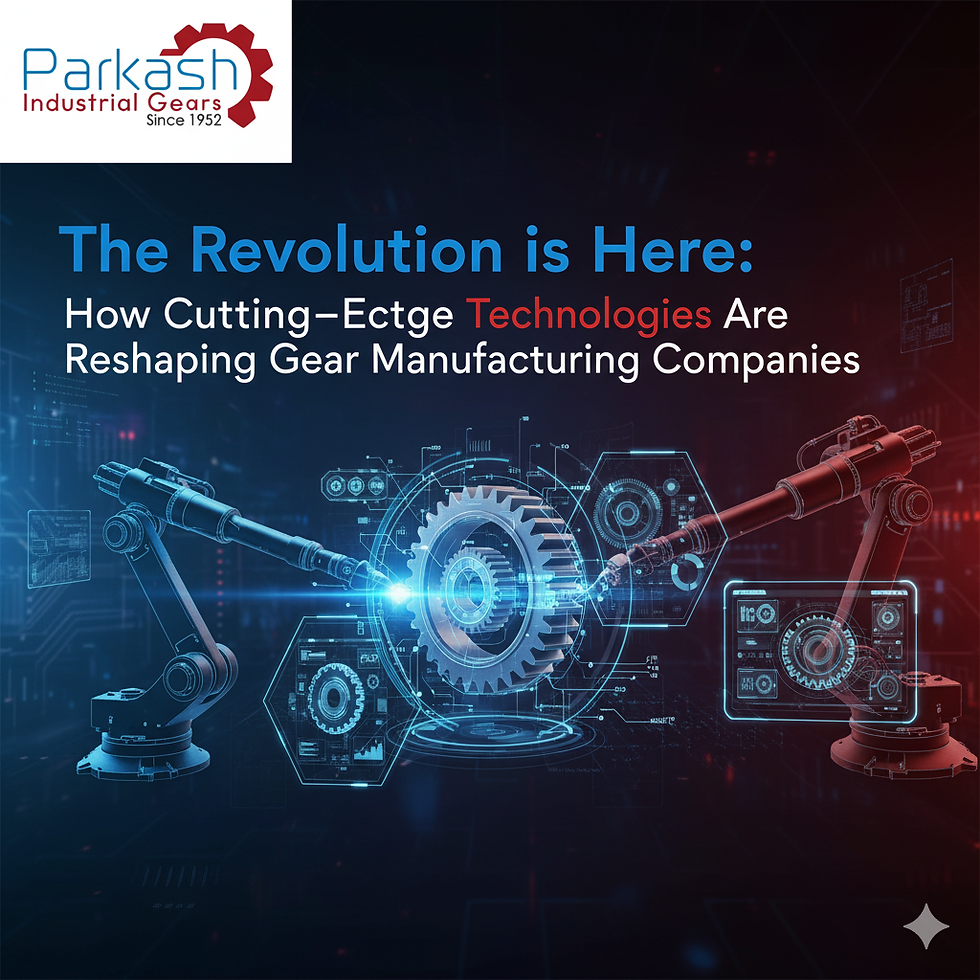The Revolution is Here: How Cutting-Edge Technologies Are Reshaping Gear Manufacturing Companies
- Prakash Gears
- Sep 20
- 3 min read
The industrial landscape is witnessing an unprecedented transformation, and gear manufacturing companies are at the forefront of this technological revolution. From automotive powertrains to aerospace systems, the demand for precision-engineered gears has never been higher. Today's manufacturers are embracing disruptive technologies that promise to redefine how we design, produce, and deliver these critical mechanical components.

3D Printing: Redefining Prototyping and Production Possibilities
Additive manufacturing has emerged as a game-changer for gear manufacturing companies worldwide. This technology enables rapid prototyping of complex gear geometries that were previously impossible or economically unfeasible to produce using traditional methods.
Key Advantages of 3D Printing in Gear Production:
Rapid iteration cycles - Engineers can test multiple design variants within days instead of weeks
Complex internal structures - Hollow gears and integrated cooling channels become achievable
Material efficiency - Zero waste production compared to subtractive manufacturing
Customization at scale - Small batch production becomes economically viable
Leading gear manufacturing companies are already leveraging selective laser sintering (SLS) and direct metal laser sintering (DMLS) technologies to produce functional prototypes and low-volume specialty gears. The automobile gear manufacturer segment particularly benefits from this technology for creating custom transmission components and specialized racing applications.
See what the future of gear making looks like right now – manufacturers are producing fully functional titanium gears directly from digital files, eliminating multiple manufacturing steps and reducing lead times from months to mere days.
Revolutionary Materials: Beyond Traditional Steel and Aluminum
The materials science revolution is providing gear manufacturing companies with unprecedented options for creating stronger, lighter, and more durable components.
Advanced Material Categories Transforming the Industry:
Carbon Fiber Composites: Offering exceptional strength-to-weight ratios, these materials are revolutionizing applications where weight reduction is critical.
Super Alloys: Nickel-based and cobalt-based alloys provide superior performance under extreme temperature and stress conditions.
Ceramic Materials: Advanced ceramics offer excellent wear resistance and operate efficiently in high-temperature environments.
Smart Materials: Shape-memory alloys and self-healing polymers are opening new possibilities for adaptive gear systems.
A prominent sprocket manufacturer recently reported achieving 40% weight reduction while maintaining strength specifications by switching to carbon fiber-reinforced polymer composites for motorcycle applications.
Robotics: The Automation Revolution in Manufacturing
Robotic automation is transforming how gear manufacturing companies approach production, quality control, and assembly processes. Modern industrial robots equipped with artificial intelligence and machine learning capabilities are delivering unprecedented precision and consistency.
Robotic Applications Revolutionizing Gear Production:
Automated machining cells with adaptive toolpath optimization
Vision-guided quality inspection systems achieving 99.9% accuracy
Collaborative robots (cobots) working alongside human operators
Automated assembly lines for complex gear train systems
The integration of IoT sensors and predictive analytics allows these robotic systems to self-optimize, reducing downtime and improving overall equipment effectiveness (OEE) by up to 35%.
Industry Leaders Embracing Disruptive Technologies
Forward-thinking gear manufacturing companies are making substantial investments in these emerging technologies. Parkash Industrial Gears exemplifies this progressive approach by integrating advanced manufacturing techniques with traditional craftsmanship to deliver superior products.
Success Stories from Early Adopters:
Automotive Sector: Major automobile gear manufacturer companies are implementing lights-out manufacturing facilities where robotic systems operate continuously, producing transmission gears with minimal human intervention.
Aerospace Industry: Leading manufacturers are utilizing 3D printing to create lightweight gear components for aircraft engines, reducing fuel consumption and maintenance requirements.
Industrial Applications: Sprocket manufacturer companies are leveraging new materials to create maintenance-free drive systems for harsh industrial environments.
The Convergence Effect: Synergistic Technology Integration
The most significant breakthroughs occur when these technologies work together. Gear manufacturing companies are discovering that combining 3D printing with advanced materials and robotic automation creates exponential improvements in capability and efficiency.
For instance, robots can now handle delicate 3D-printed ceramic gears with precision impossible for human operators, while AI systems optimize printing parameters in real-time based on material properties and environmental conditions.
Future Outlook: What's Next for Gear Manufacturing Companies?
The trajectory is clear – gear manufacturing companies that embrace these disruptive technologies will dominate the market. Emerging trends include:
Digital twins for predictive maintenance and optimization
Blockchain integration for supply chain transparency
Quantum computing applications for complex design optimization
Sustainable manufacturing practices driven by advanced recycling technologies
As an established sprocket manufacturer and automobile gear manufacturer, companies like Parkash Industrial Gears are positioning themselves at the intersection of tradition and innovation, ensuring they remain competitive in this rapidly evolving landscape.
Conclusion: Embracing the Manufacturing Renaissance
The future belongs to gear manufacturing companies that dare to innovate. Those who integrate 3D printing, advanced materials, and robotics into their operations will not only survive the industrial transformation but will lead it. The question isn't whether these technologies will reshape the industry – it's how quickly manufacturers will adapt to harness their full potential.
The manufacturing renaissance is here, and it's powered by the perfect storm of technological advancement, market demand, and human ingenuity.



Comments